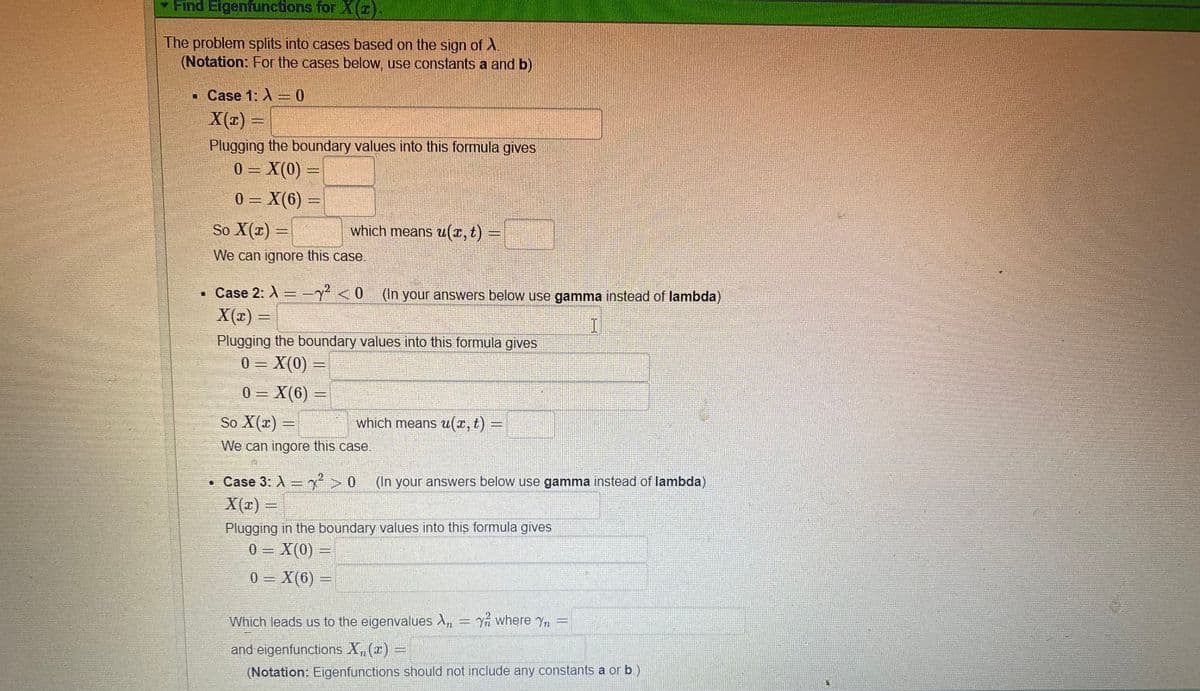The problem splits into cases based on the sign of ). (Notation: For the cases below, use constants a and b) • Case 1: A = 0 X(z) = %3D Plugging the boundary values into this formula gives 0 X(0) = %3D %3D 0 = X(6) = So X(x) = %3D which means u(r, t) = %3D We can ignore this case. Case 2: A = -y? < 0 (In your answers below use gamma instead of lambda) X(x) = %3D Plugging the boundary values into this formula gives 0 = X(0) = 0 = X(6) So X(x) = %3D %3D which means u(x, t) = We can ingore this case. Case 3: A = y >0 (In your answers below use gamma instead of lambda) X(x) = %3D Plugging in the boundary values into this formula gives 0 = X(0) = 0 = X(6) =
The problem splits into cases based on the sign of ). (Notation: For the cases below, use constants a and b) • Case 1: A = 0 X(z) = %3D Plugging the boundary values into this formula gives 0 X(0) = %3D %3D 0 = X(6) = So X(x) = %3D which means u(r, t) = %3D We can ignore this case. Case 2: A = -y? < 0 (In your answers below use gamma instead of lambda) X(x) = %3D Plugging the boundary values into this formula gives 0 = X(0) = 0 = X(6) So X(x) = %3D %3D which means u(x, t) = We can ingore this case. Case 3: A = y >0 (In your answers below use gamma instead of lambda) X(x) = %3D Plugging in the boundary values into this formula gives 0 = X(0) = 0 = X(6) =
Elementary Linear Algebra (MindTap Course List)
8th Edition
ISBN:9781305658004
Author:Ron Larson
Publisher:Ron Larson
Chapter7: Eigenvalues And Eigenvectors
Section7.1: Eigenvalues And Eigenvectors
Problem 65E
Related questions
Question
the ends of a string of length L are secured at both ends. Its initial shape is straight but it is vibrating with initial velocity f(x)=x(L-x).
choose the PDE and boundary/initial conditions that model this scenario.

Transcribed Image Text:Find Eigenfunctions for ).
The problem splits into cases based on the sign of A
(Notation: For the cases below, use constants a and b)
• Case 1: A = 0
X(x)
Plugging the boundary values into this formula gives
0 = X(0)
%3D
0 = X(6)
So X(x) =
which means u(x, t) =
We can ignore this case.
• Case 2: A =-y² <0
(In your answers below use gamma instead of lambda)
X(x) =
Plugging the boundary values into this formula gives
0 – X(0)
0 = X(6) =
So X(x) =
which means u(x, t) =
We can ingore this case.
• Case 3: A= >
X(x) =
(In your answers below use gamma instead of lambda)
Plugging in the boundary values into this formula gives
0 = X(0) =
%3D
0 = X(6)
Which leads us to the eigenvalues A, = Yn where Yn =
and eigenfunctions X,(z) =
(Notation: Eigenfunctions should not include any constants a or b.)
Expert Solution
This question has been solved!
Explore an expertly crafted, step-by-step solution for a thorough understanding of key concepts.
This is a popular solution!
Trending now
This is a popular solution!
Step by step
Solved in 5 steps

Knowledge Booster
Learn more about
Need a deep-dive on the concept behind this application? Look no further. Learn more about this topic, advanced-math and related others by exploring similar questions and additional content below.Recommended textbooks for you

Elementary Linear Algebra (MindTap Course List)
Algebra
ISBN:
9781305658004
Author:
Ron Larson
Publisher:
Cengage Learning

Linear Algebra: A Modern Introduction
Algebra
ISBN:
9781285463247
Author:
David Poole
Publisher:
Cengage Learning

Elementary Linear Algebra (MindTap Course List)
Algebra
ISBN:
9781305658004
Author:
Ron Larson
Publisher:
Cengage Learning

Linear Algebra: A Modern Introduction
Algebra
ISBN:
9781285463247
Author:
David Poole
Publisher:
Cengage Learning